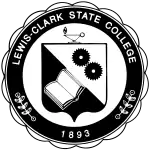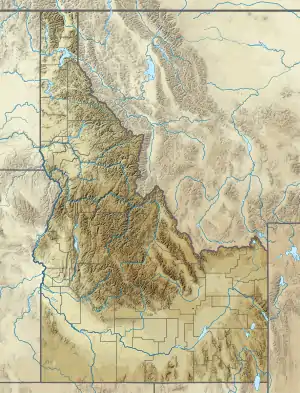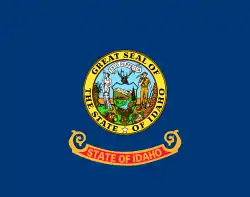Lewis–Clark State College
Lewis–Clark State College is a public college in Lewiston, Idaho. Founded 128 years ago in 1893, it has an annual enrollment of approximately 3,600 students. The college offers more than 130 degrees and is well known for its social work, criminal justice, education, nursing, and technical programs.
 | |
| Type | Public college |
|---|---|
| Established | 1893 |
Academic affiliations | Space-grant |
| President | Cynthia Pemberton |
| Students | 3,684 [1] |
| Location | , , United States 46.411°N 117.026°W |
| Campus | Urban |
| Colors | Navy, White, & Red[1] |
| Nickname | Warriors |
Sporting affiliations | NAIA – Frontier Conference |
| Website | www |


History
In 1893, Idaho Governor William J. McConnell signed an act on January 27 authorizing the establishment of the Lewiston State Normal School in Lewiston.[2] There was a catch, however: "Provided the mayor and common council of that city on or before May 1, 1893, donate ten acres, within the city limits and known as part of the city park, and authorizing the said mayor and council to convey to the trustees of said normal school the said tract of land," etc.
The first Trustees on the school's Board were James W. Reid (who had done the most to shepherd the authorization bill through the legislature), Norman B. Willey (who had just stepped down as Idaho governor), Benjamin Wilson (a previous gubernatorial candidate), J. Morris Howe, and C. W. Schaff. Reid was elected President of the Board,[3] a position he held until his death in 1902.
Lewiston residents lost no time in obtaining the required space for the school. However, the legislature acted slowly in providing construction funds, and then construction lagged. George E. Knepper[3] had been hired as first President of the Normal School. Frustrated by the delays in getting his building, Knepper leased space in downtown Lewiston and opened for classes on January 6, 1896. The building itself was not ready until May.[3] Over the next several years, more structures were added to the campus, including dormitories and a gymnasium.[4][5]
In keeping with the Normal school philosophy, Lewiston Normal focused on practical, hands-on training for new teachers. That meant they provided a great deal of “manual training” – what we would call vocational education. Also, to insure that teachers truly knew how to handle a classroom, the School ran an on-campus training school. In it, real teachers taught real pupils, but student teachers also learned-by-doing under the supervision of experienced teacher-critics.
Until the 1920s one-room schools served well over half of Idaho's primary students. In most, only the teacher knew anything at all about running a school. Thus, in Keith Petersen's words,[3] “teachers assumed responsibility for shaping a district's entire educational policy.”
World War I certainly impacted the nation's normal schools, but not as much as it did conventional institutions. Generally, male students were in the majority at regular colleges, many of which experienced brutal enrollment losses. Normal schools attracted a predominantly female student body, so the declines were much smaller – about 15% at Lewiston Normal.
The school experienced a painful crisis on December 5, 1917, when the Administration Building suffered severe damage in a fire, [6][7] later determined to be arson by a student.[4][5] Its cupola collapsed into the gutted interior of the main structure and the older east wing was totally destroyed. Lewiston Normal survived that disaster and continued to grow, as the demand for pre-college teachers increased. However, by the late 1920s, the "normal school" idea was being supplanted by a "teachers college" approach. Such colleges still focused on teacher education, but now students could earn a bachelor's degree – more and more often required for certification. Recognizing this trend, school supporters began a campaign to change Lewiston Normal's status. They also began the painful process of upgrading the faculty – inciting much ill will.
Supporters also fought an ongoing battle just to keep the school open; some legislators still wanted to close the Normals to save money. The advent of World War II squelched that notion. Not only did the school continue to turn out desperately needed teachers, it also expanded its nurse-training program, and produced large numbers of fliers in its Navy Air School. In 1943, the Board of Education raised the school to full four-year status and became North Idaho Teachers College (NITC).[8][9] Now with the ability to grant a B.Ed., school leaders took it upon themselves to use the name Northern Idaho College of Education (NICE), and the legislature approved the name change in 1947.[10]
The school got another temporary reprieve from the cost-cutters when a deluge of veterans funded by the G.I. Bill hit the campus after the war. However, that wave passed, and in 1951 budget hawks succeeded in closing the school, as well as its counterpart, SICE in Albion in southern Idaho.[11][12] The state's other colleges had assured legislators that they could supply all the teachers needed. That promise proved disastrously wrong: In just three years, the state found itself issuing nearly 40% more provisional teaching certificates than it had in 1951.[3]
Under that pressure, the legislature re-opened the school as Lewis–Clark Normal School in 1955[13] as a two-year school under the administration of the University of Idaho, thirty miles (50 km) north in Moscow.[14] The first dean of LCSN was appointed for the third year in 1957,[15][16] and enrollment was 319 in the fall of 1961.[17] The arrangement with UI proved difficult and it ended abruptly in 1963 when the affiliation seemed like it might damage the university's academic accreditation.
The ongoing need for teachers, a developing shortage of nurses, and a new push for vocational education from the federal government combined to rescue the school from oblivion. The state legislature voted to elevate it to four-year status in 1963 but did not approve funding until two years later.[18][19] Enrollment of the now-independent, four-year school grew, by from 465 in 1964 to 1,033 in the fall of 1968.[20] It continued to grow and in July 1971 the name was officially changed to Lewis–Clark State College.[21] It was the last Normal school in the country to make the change.[3]
Athletics
Lewis–Clark State competes in intercollegiate athletics in the National Association of Intercollegiate Athletics (NAIA), primarily in the Frontier Conference. The school colors are navy blue, white, and red,[1] with a team nickname of "Warriors." Men's sports include baseball, basketball, cross country, golf, tennis, and track & field. Women's sports teams are nicknamed "Lady Warriors" and include basketball, cross country, golf, tennis, track & field, and volleyball.
"Warriors" was adopted after the school reopened in 1955;[22][23][24][25] earlier nicknames include "Pioneers" in the 1930s,[26] and "Loggers" in the 1940s and early 1950s.[27][28][29]
Baseball
Absent for a decade (1952–61),[30][31] baseball returned as an intercollegiate sport in 1962.[32][33][34][35] Since 1984, the team has won nineteen NAIA national championships;[36] sixteen were under head coach Ed Cheff, who retired after 34 years in 2010.[37] LCSC has hosted the NAIA World Series at Harris Field since 2000; it also hosted from 1984–1991.[36] The elevation of the field is approximately 850 feet (260 m) above sea level.
Notable alumni
- Marvin Benard, retired MLB player, San Francisco Giants
- Vic Darensbourg, former MLB pitcher
- Steve Decker, retired MLB player
- Donnie Ecker, Major League Baseball coach for the San Francisco Giants
- Tom Edens, retired MLB player
- Jason Ellison, Major League Baseball outfielder, plays for Texas Rangers system[38]
- Carlos Fisher, MLB player, Cincinnati Reds
- Keith Foulke, former MLB player, Oakland Athletics
- Blaine Hardy, baseball player[39]
- Bucky Jacobsen, former MLB player
- Aprilynne Pike, #1 New York Times best-selling author of young adult fiction
- Steve Reed, former relief pitcher in Major League Baseball[40]
- Brendan Ryan, MLB player, New York Yankees
- Seth Brown, MLB player, Oakland Athletics
References
- "Quick facts". Lewis-Clark State Athletics. Archived from the original on September 9, 2013. Retrieved December 26, 2012.
- James H. Hawley, History of Idaho: The Gem of the Mountains, The S. J. Clarke Publishing Company, Chicago (1920).
- Keith C. Petersen, Educating in the American West: One Hundred Years at Lewis–Clark State College, 1893–1993, © Lewis–Clark State College, Confluence Press, Lewiston, Idaho (1993).
- "Great celebration greeted opening of normal school". Lewiston Morning Tribune. August 13, 1961. p. 9-centennial.
- "Lewiston Normal is pioneer teacher college of Idaho". Lewiston Morning Tribune. May 3, 1936. p. 3-sec.3.
- "Normal school is burned". Lewiston Morning Tribune. December 6, 1917. p. 5.
- "Adjust loss at $84,005". Lewiston Morning Tribune. December 15, 1917. p. 9.
- "35 CAA cadets reach Lewiston". Lewiston Morning Tribune. September 4, 1943. p. 10.
- "Church, Owens may do passing for Loggers". Lewiston Morning Tribune. September 4, 1946. p. 8.
- "Archived copy". Archived from the original on 2015-03-03. Retrieved 2013-08-18.CS1 maint: archived copy as title (link)
- "College closure today marks end of historic era". Lewiston Morning Tribune. August 10, 1951. p. 10.
- "Another fight on 2 schools found likely". Spokane Daily Chronicle. October 9, 1956. p. 3.
- "At least 100 pupils expected at Lewis–Clark Normal School". Lewiston Morning Tribune. August 10, 1955. p. 5.
- "Normal course action awaited". Spokesman-Review. June 2, 1955. p. 7.
- "Full-time administrator named for Lewis–Clark Normal School". Lewiston Morning Tribune. July 31, 1957. p. 14.
- "Idaho school dean is named". Spokesman-Review. August 1, 1957. p. 6.
- "162 enroll at college". Lewiston Morning Tribune. Feb 6, 1962. p. 9.
- "Lewis-Clark college gets 4-year status". Spokesman-Review. Associated Press. March 19, 1965. p. 6.
- Hall, Bill (August 18, 1967). "Can Lewis-Clark find security and strength in legislature?". Lewiston Morning Tribune. p. 2.
- Swank, Gladys Rae (November 30, 1968). "Lewis-Clark college in 75th year". Spokane Daily Chronicle. p. 5.
- "College name change takes effect". Lewiston Morning Tribune. June 30, 1971. p. 2.
- "Junior college group invites Lewis-Clark". Lewiston Morning Tribune. May 6, 1956. p. 11.
- "LCNS starting assignments puzzle coach". Lewiston Morning Tribune. November 27, 1956. p. 8.
- "Crusaders beat freshman in overtime". Lewiston Morning Tribune. December 16, 1956. p. 10.
- "LCNS Warriors meet frosh today". Lewiston Morning Tribune. May 6, 1958. p. 8.
- "Lewiston Normal wins". Spokane Daily Chronicle. (Washington). October 19, 1936. p. 6.
- "Loggers meet Nampa quintet tonight at 8". Lewiston Morning Tribune. February 11, 1941. p. 8.
- "NICE Loggers to meet SICE". Spokesman-Review. November 20, 1948. p. 10.
- "Loggers return from 4-game road journey". Lewiston Morning Tribune. March 5, 1951. p. 2.
- "Loggers split final home games". Lewiston Morning Tribune. May 31, 1951. p. 10.
- "Loggers sweep Eastern series, compile best modern day record". Lewiston Morning Tribune. Associated Press. June 3, 1951. p. 8.
- "LCN plans baseball nine next spring". Lewiston Morning Tribune. December 13, 1961. p. 13.
- "LCN baseball schedule set". Lewiston Morning Tribune. Feb 22, 1962. p. 12.
- "20 Warriors answer call for baseball". Lewiston Morning Tribune. March 13, 1962. p. 8.
- "Warriors bow to CBC frosh". Lewiston Morning Tribune. March 31, 1962. p. 8.
- "Baseball championship history" (PDF). 2012. p. 1.
- "Legendary Lewis-Clark State baseball coach Ed Cheff to retire". NAIA.org. June 30, 2010.
- "Jason Ellison". Baseball-Reference.Com. Retrieved September 14, 2012.
- Reisenweber, Tom (2013-04-29). "Hardy added to Erie roster | Extra Innings". Goerieblogs.com. Retrieved 2014-04-08.
- "Steve Reed Stats". Baseball Almanac. Retrieved December 3, 2012.
